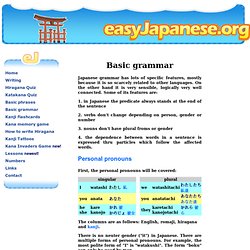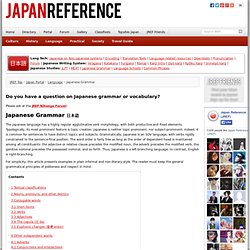

Dynamic Periodic Table. Learning Japanese. Education. List of Free Audiobooks. Basic Grammar. Japanese grammar has lots of specific features, mostly because it is so scarcely related to other languages.

On the other hand it is very sensible, logically very well connected. Some of its features are: 1. in Japanese the predicate always stands at the end of the sentence 2. verbs don't change depending on person, gender or number 3. nouns don't have plural froms or gender 4. the dependence between words in a sentence is expressed thru particles which follow the affected words. Personal pronouns First, the personal pronouns will be covered: The columns are as follows: English, romaji, hiragana and kanji. There is no neuter gender ("it") in Japanese.
For "you" males can say "kimi", informally. "They" has a feminine and masculine form: "kanojotachi" and "karetachi" respectively. Particles Particles are suffixes which follow promptly after the word that they relate to. Notice, that "wa" is written as "ha" in hiragana. Also an exception. The main function of "no" is to mark possession.
Mozilla Firefox. NIHONGO-JUKU. Japanese Lessons & Video Site - Search (beta) Japanese. Japanese learning tools. Kanji practice: Kanji # 0352. Yoshida Institute - Learning Kanji. 一 - KANJIDAMAGE. List of Japanese verbs. Bad Japanese Words. Bad Japanese Words Okay, Okay, here's the long promised Japanese slanguage file.

First, some notes:I copied this off a Japanese Language-soft, so any errors in fact, tact, or syntax are now your problem.The words & phrases contained in this file are anglicized into an approximation of speech & are not standardized Japanese translations, however, they will correctly convey your meaning when spoken.My display-link didn't support all the lang-soft's fonts, so treat "ä ë ï ö ü & ÿ" as long vowels.This text is a bit revealing about the Japanese and their views on the rest of the (non-Japanese) world.
If it offends your delicate sensibilities, don't read it, clavie! When the slang expression has multiple Japanese translations, the phrases are listed from most polite to least polite! Any questions? Fenris (2:23:45/5-29-56) Hoi chummers, Rita here. I have cleaned up his original text and added gender markings: [f/m] & (b/g>g) throughout it. Ricochet Rita, Razorgal (8:12:53/6-1-56) [Netenna-yo! Japanese Grammar - Japan Reference. Do you have a question on Japanese grammar or vocabulary?

Please ask at the JREF Nihongo Forum! The Japanese language has a highly regular agglutinative verb morphology, with both productive and fixed elements. Typologically, its most prominent feature is topic creation: Japanese is neither topic-prominent, nor subject-prominent; indeed, it is common for sentences to have distinct topics and subjects. Grammatically, Japanese is an SOV language, with verbs rigidly constrained to the sentence-final position.
The word order is fairly free as long as the order of dependent-head is maintained among all constituents: the adjective or relative clause precedes the modified noun, the adverb precedes the modified verb, the genitive nominal precedes the possessed nominal, and so forth. For simplicity, this article presents examples in plain informal and non-literary style. Textual classifications 太陽が|東の|空に|昇る。 Taiyou ga | higashi no | sora ni | noboru The sun rises in the eastern sky. 「木下さんは、背が高いですね。」 Basic skit list. Japanese alphabet a to z: KATAKANAArchive. Japanese Sound effects in Manga and what they mean. らぶたまたち~、ちょっと聞いてよ~! List of Japanese verbs.